Уроки "Seven days with Aesop’s fables"
Seven days with Aesop’s fables
( for students of the 5 – 8 forms )
Interactive lessons
Вчителя англійської мови
Кучер Олени Федорівни
Day 1
Lesson: Fables
Time: 45 min.
Objective: Students will learn and identify the features of the fable genre (animals with human qualities, moral lesson learned) and identify the main idea, problem, resolution (lesson learned). Students will also make connections after reading.
Materials: Chart paper for story mapping. Individual story maps.
Introduction/Model:
“I have a book that I would like to read to you. As I read I want you to notice that this is not just one story. It is full of great stories. These stories are a special type of story called a fable. A fable is a story that has talking animals in it and teaches a lesson about how people should act. As we read the stories we will keep track of them on our story map. When you notice a character, what happened in the story, or what they lesson the story taught us raise your hands and we will add it to our story map.
Story Characters What happened Lesson
Read the first story “The Rabbit and the Turtle” to the children and fill in the first line of the chart and explain to the children “I write the title of the story under story, they I write the characters next.” Keep reading then say “Now I need to write what happens.” Finish reading the story, then say “Last I need to write the lesson I learned, which was not to be boastful and keep trying and you can finish anything.”
Guided Practice:
“Now we are going to read two more fables and we are going to work together to fill in this char for this story. When you hear something that belongs in one of these columns please raise your hand.” Begin reading the story and stop when someone raises their hand. Have them come to the board and fill in their answers.
Independent Practice:
“Now you will fill in your own story maps for the next two stories. I will read the story and take some breaks to give you time to fill in your story maps.”
Assessment:
Have the class do a gallery walk and look at each other’s story maps to see what is similar and what is different. As they do this walk around and check each child’s story map to see if they have comprehended what the features of a fable are, and how to find them.
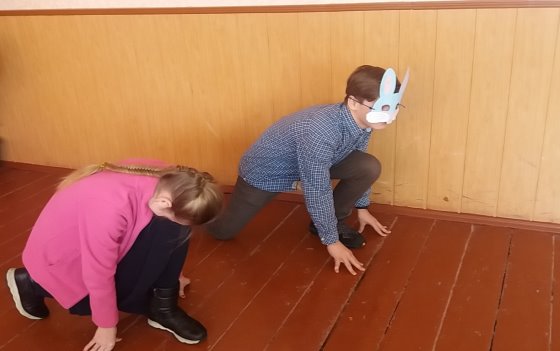
Day 2
Time: 45 minutes
Objective: Students will begin collecting and organizing ideas to help them write their own fables. The day will end with them choosing their animals and lessons to teach in their fable.
Materials: Story maps from day 1, fables, mind maps.
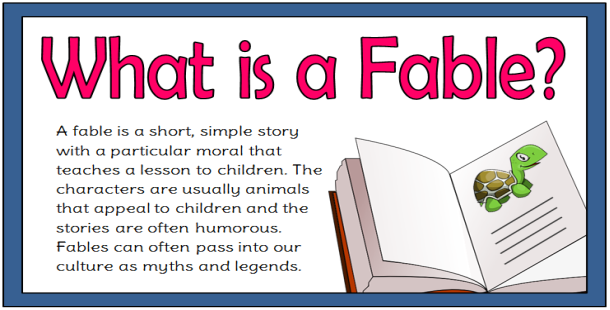
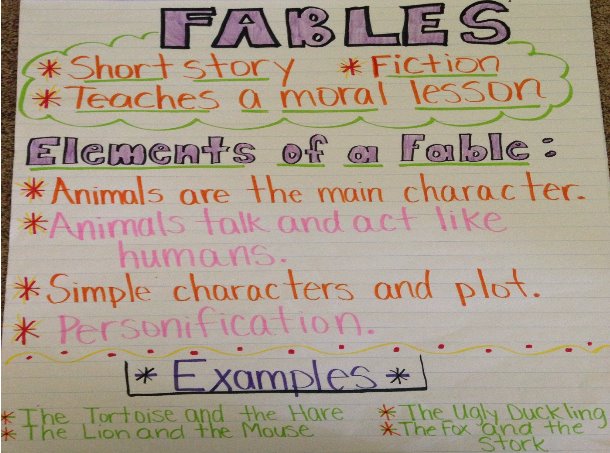
Review:
“Please take out your story maps from yesterday. While you look at those I just want to take a minute and review what is special about fables. Remember that fables are short stories that have animals with human qualities and teaches a lesson about how humans should act. Let’s review our lists from yesterday.” Read over the list making it a point to focus on the animals, what they did, and the lesson learned. “Let’s make sure we understand what special elements are in a fable by reading one more fable and putting this one on our story map as well.” Read the story while stopping and giving the children time to fill out their story map as you fill the one out on the chart paper.
Model:
“I think it would be great to write my own fable. I am a teacher and love teaching so I think that I could find a way to teach a lesson through animals. Let’s see I need to think of some characters for my story. I will put a list of some possible animals on my story map. I like cats so I could at a cat to my list, I could also add a mouse, dog, moose, bear, horse, or an eagle. It is easy to come up with a list of animals since we see animals every day. Now I need to come up with a lesson to teach. I have noticed that sometimes people are not very nice to each other out on the playground so maybe I could teach a lesson on being nice. I could even write a story about why I need to listen to my mom when she asks me to do something. So I will add those ideas to my list. Looking at my list, I think I will choose a moose and a bear for my animals. I also think I would like to write about being nice so I am going to circle that one so I can remember for tomorrow.”
Guided Practice:
“We are going to brainstorm fable characters and lessons together as a class. Let’s brainstorm some animals and fill in our class story chart. Before we start writing them down please turn and tell you neighbor what animal you are thinking of.” Allow children to come up and add their ideas to the class story chart. “Now let’s come up with lessons that we can teach that will help people want to be better. You can take something that has happened to you. Turn and share with your neighbor, now who wants to share with the class?” Again allow them to come up and write their ideas.
Independent Practice:
Hand each child their own story map “Now you are going to brainstorm your own characters (remember fables have animals that act like humans). I also want you to think of a lesson that you would like others to learn remember you can use something that has happened to you, that you wish others would learn not to do.”
Assessment:
Allow the students to turn and share their completed story maps with a neighbor. While they are sharing walk around and listen to what people are coming up with. If they are coming up with too abstract of ideas discuss with them how to make it easier to put into a short story. Have them circle the two animals that they think they would like to write about the most, as well as the lesson they think they would like to teach the most.
Accommodations:
Have a picture list of many animals and discuss with small groups what problems they have faced and make a list for them to look at and choose from.
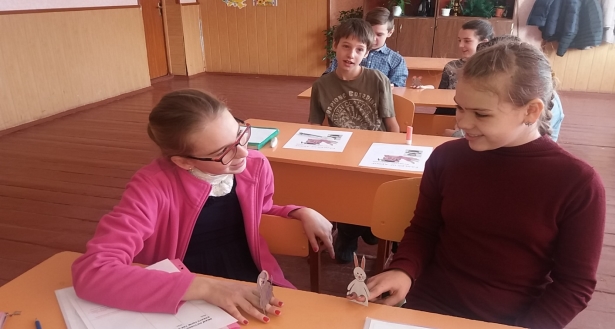
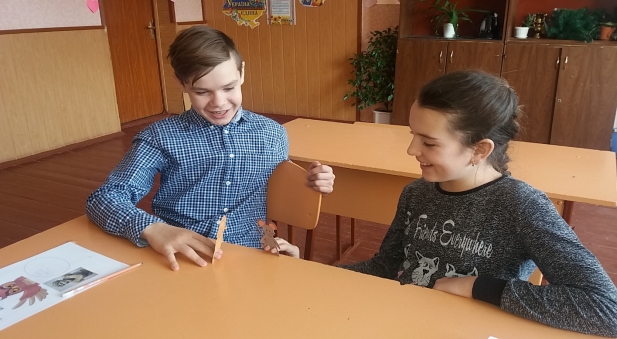
Day 3
Time: 45 minutes
Objective: Students will comprise a first draft of their stories using a beginning, middle, and end, writing map.
Materials: Story maps from day 1 (class); individual story map from day 2; beginning, middle, and end graphic organizer; and Aesop’s fables
Mini-Lesson:
“Fables (like all stories) have a beginning (where they start), a middle (what happens or the main part), and the end (where we learn what the lesson is). Today you are going to be working on a beginning, middle, and end graphic organizer to begin getting your fables put together. Before we begin let’s read another fable and find out what happens in the beginning, middle, and end of a fable.” Read the story and stop to discuss each phase of the fable. Have the students turn and talk about what they notice about the details in each phase of the fable.
Model:
“Now I am going to start my graphic organizer for my fable. I know I need to tell about the animals and how they met so I think I will write ‘Once there was a moose that was jumping rope out at recess one day. Bear came along and asked Moose if he could play too.’ Now I need to tell what happened in the story, but since I don’t have a lot of room I have to write a little information. ‘Bear started playing with Moose but took his jump rope away. The next day out at recess Bear was looking for a friend to play with but no one would play with him.’ Now for the end where we find out what the lesson is ‘Bear asked Moose to play, but Moose just looked at Bear and said “I would prefer to play with friends who will share with me and not be bossy.”
Guided Practice:
“We are going to take a look at our class fable story chart. We decided on________ and ________ for the animals, and _________________ for the lesson that should be taught. Now let’s look at our graphic organizer, we should begin with the animals meeting, and who is the mean one. So turn and tell your neighbor how you think the animals should meet, as well as who is the mean one.” Decide on one meeting and the animal that causes the problem. Write that
in the beginning section of the graphic organizer. “Now let’s brainstorm or think of how the problem can come up, turn and tell your neighbor what you think should happen.” Choose one to write on the graphic organizer under the middle section. “Last how does the ______________ learn his or her lesson? Turn and tell your neighbor.” Choose one and write it for the ending portion of the graphic organizer.
Independent Practice:
“Now take out your story map from yesterday and use those ideas that you came up from yesterday to start your graphic organizer for your story. Remember to come up with how the animals meet and who is the mean one for the beginning of the story. Then come up with what happens for the middle of the story. And what lesson they learned for the end of the story.”
Accommodations:
Make a list of the steps on the board to help the students fill out their graphic organizers. Work with small groups as needed (interviews). Leave up the class organizer for the students to look at for guidance.
Assessment:
Collect the student’s graphic organizers to check for understanding of the layout of fables. If a student is showing a misunderstanding of any of the elements take the time to review and re-teach in small groups.
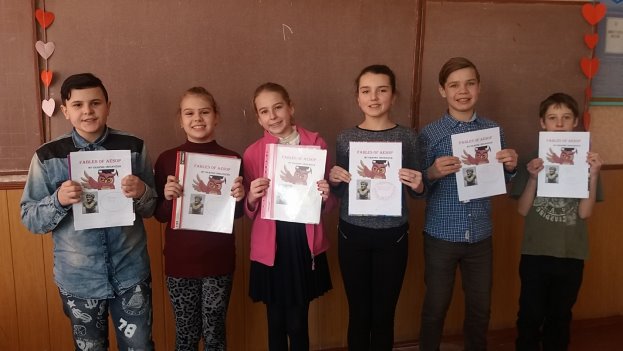
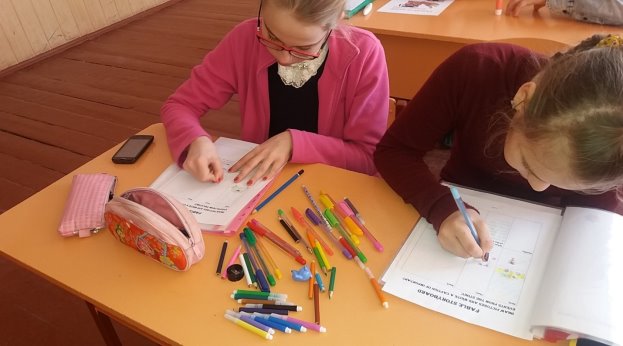
Day 4 and Day 5 (re-teach as necessary)
Time: 45 minutes
Objective: Students will revise, add detail, and write in complete sentences to create a more indepth story.
Materials: Writing book, story map from day 1 and 2, graphic organizer from day 3, and fables
Mini-Lesson:
“Now that we have a general plan for our fable we are going to work on creating complete sentences that contain good adjectives. Excellent authors write in complete sentences (a complete thought) because it makes their stories easier to read.” Write the sentence ‘The rabbit in the hole.’ “Now this isn’t a complete thought because we don’t know anything about why the rabbit is in the hole.
Now look at this sentence ‘The rabbit is hiding in the hole.’ Now the sentence tells who it is and what they are doing so it is a complete sentence. Authors also use adjectives (or describing words) that paint a better picture in our minds. So looking at the sentence ‘The rabbit is hiding in the hole.’ Look at the difference that two simple adjectives can make. ‘The small white rabbit is hiding in the hole.’ Now we know what the rabbit looks like. Today we are going to work on adding detail to our stories and writing in complete sentences.” “Listen as I read another fable to you. I am going to read it two different ways. I want you to tell me which story you like better.” While reading the first time leave out descriptive words and read the sentences as incomplete sentences. The second time read the story the way it is written; then ask “What story did you like better?” Lead them to the realization that the second story painted a better picture and made more sense.
Model:
“I am going to take out my beginning, middle, and end story map to write my story. Now my story does not sound very interesting right now and I need to add some detail to it. I think I could tell a little more about Moose, and Bear. What they are like, what they look like, what type of friend they are. Maybe I could add detail about what they are doing out at recess, and who they are playing with. But whatever I do I need to make sure I am telling the story in complete sentences. I don’t want it to look like this. “Moose jump rope. Bear took rope. No play with bear.” Those are not complete sentences.” Write some complete sentences adding detail for the students to see. Stop along the way to point out the details and thoughts.
Guided Practice:
“Let’s work on our class fable now. We need to create better sentences to go in our story. Think about ways to make our story better. Remember we can tell more about our animals like: what they look like, what they do, how they act, anything that we want people to know. Let’s start with the beginning, what can we add to the beginning of our story to make it more interesting? Now turn and share your idea with a partner.” Write one of the ideas on chart paper for the story. Continue the same procedure with the middle and end (guiding the students as necessary to add detail to the story).
Independent Practice:
“You need your organizer from yesterday and your writing books. Write your fable in your writing books, making sure you add detail and stopping to read what you have written to make sure it is a complete sentence. Whatever you think write it down, you may be tempted to leave out some words but remember those same words that you are thinking are the same words that should make up your sentences.
Accommodations:
Have students team up and talk about what they want to write before they write it. Do mini interviews before starting so they can see what it is like to speak in complete sentences.
Assessment:
Walk around and do conferences with the students as they are working on their fables. If you do not get to students gather their fables and check for comprehension.
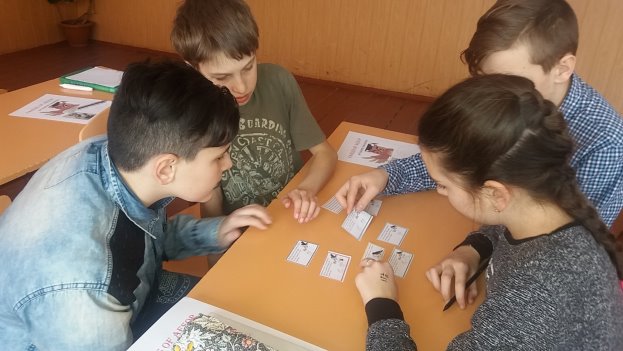

Day 6
Time: 45 minutes
Objective: Students will become editors and learn to check for and correct capitalization, punctuation, and spelling of sight words in written work.
Materials: Writing books, class fable, teacher fable written with missing punctuation, capitalization, and spelling errors, correcting utensil, funny glasses for editing.
Lesson:
“No author is perfect we all make mistakes; that is why there is always time to edit or check our work for mistakes. When authors have finished writing their stories they send it to an editor. The editor has a very important job; they have to make sure there are no mistakes in the author’s story. The editor reads the story very carefully and fixes any spelling, capitals, and punctuation mistakes that he or she finds in the story. Today you are going to become editor and make sure the fables are ready to publish.”
Model:
“I am going to edit my story from yesterday. To get ready I am going to put my editing glasses on (these will help me remember to read carefully and look for mistakes). I start at the beginning of my story and read very carefully.” Read out loud to the children and do think-a-loud's when you find errors.
Guided Practice:
“We also need edit our class fable. Everyone put on your editing glasses and read over our class fable with me very carefully, looking for any mistake we might have made when we were doing our first writing. Read it carefully and turn and tell your neighbor any mistake that you have found.” Invite class members to come up and fix any mistake they find and discuss with the class why it was a mistake.
Independent Practice:
“It is your turn to be an editor. Trade writing books with your partner and check their writing for any mistakes. When you find a mistake fix it. When you are both finished editing each others work explain what mistakes you found and how you think they should be fixed.”
Assessment:
As students are editing work walk around and meet with groups to check for understanding of editing work. Collect the writing books when finished and check.
Accommodations:
Work with small groups reading over their work with them and guiding them to find their errors.
Day 7
Time: 45 minutes
Objective: Students will publish and illustrate their finial fable and share it during our author’s day.
Materials: Writing book, final copy paper, and plain white art paper.
Lesson:
“Today you are going to make your final copy of your fable, illustrate it and publish it. Take out your writing book and look at your fable. It should have the corrections that your editor mad and it looks rather messy. Authors do not send their messy copies to be published (people would not want to read a copy that was messy). To publish your final copy of your fable you are going to copy it to the final copy paper without changing the story, and in your best handwriting. When you finish with that you will illustrate it and get it ready for author’s day.”
Model:
“I am going to take out my fable that was edited yesterday. I am also going to take out my final copy paper and begin copying. As I copy my fable to my final copy paper I am going to make sure I write nice and neat. I am also going to go back and read the sentence that I wrote to make sure I didn’t leave any words out.” Do show them how you write nice and neat doing think aloud's. Then do a think aloud for adding the illustrations for your fable.
Guided Practice:
“I need some people to come up and copy our fable onto our final copy paper.” Invite several children to come up and copy one sentence at a time to the final copy paper. “Now that we have finished writing our final copy we need to add illustrations to help tell the story. Take the blank piece of art paper and illustrate a picture that goes along with our class fable.” When everyone is finished compile the class fable and the illustrations into a class book for the class library.
Independent Practice:
“Take your writing book and your final copy paper and copy your fable using nice neat handwriting to your final copy paper. Make sure you stop to read each sentence as you write it to make sure you didn’t leave any words out. When you are finished add illustrations to help tell your story.”
Assessment:
Walk around and check for handwriting, and help as needed. Have each child share their fable during author’s day. After each child shares their story have the rest of the class tell the lesson they learned from their friends fable.23
_________
23 file:///D:/АЕЗОП/Genre-Unit-Reading-and-Writing-Fables-TeacherLINK.pdf
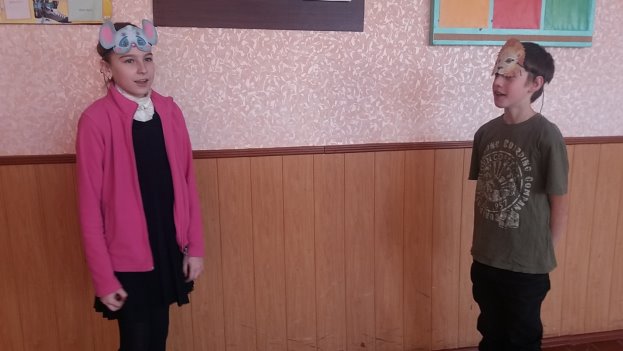

![]()
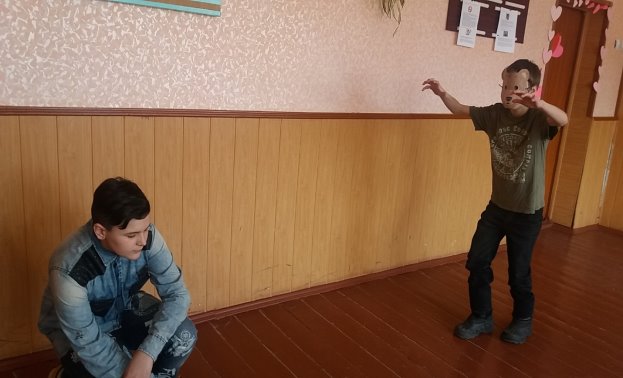
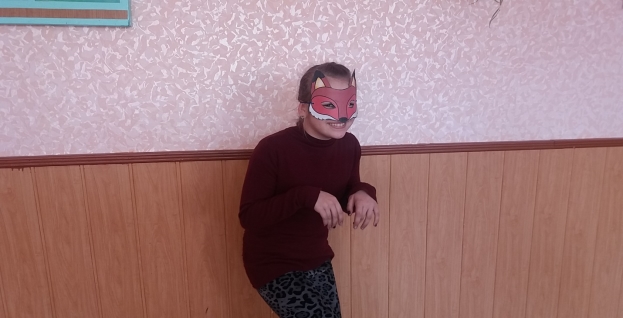
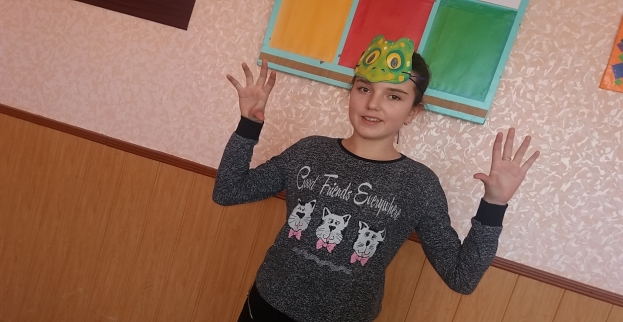


про публікацію авторської розробки
Додати розробку
